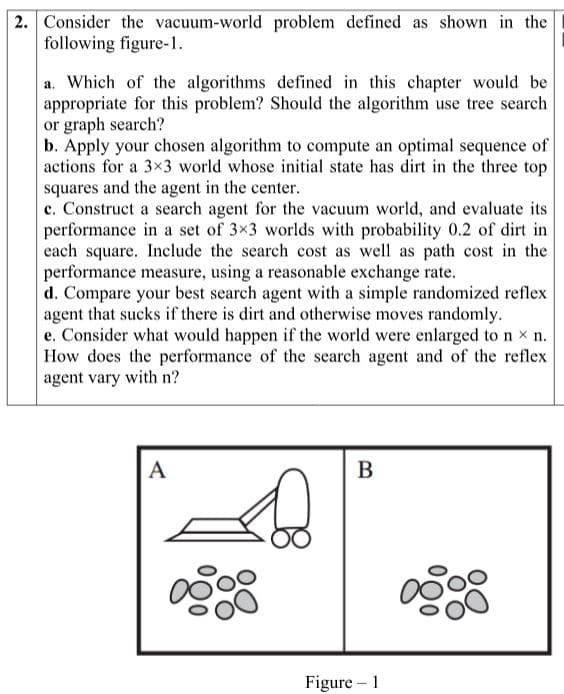2. Consider the vacuum-world problem defined as shown in the following figure-1. a. Which of the algorithms defined in this chapter would be appropriate for this problem? Should the algorithm use tree search or graph search? b. Apply your chosen algorithm to compute an optimal sequence of actions for a 3×3 world whose initial state has dirt in the three top squares and the agent in the center. c. Construct a search agent for the vacuum world, and evaluate its performance in a set of 3x3 worlds with probability 0.2 of dirt in each square. Include the search cost as well as path cost in the performance measure, using a reasonable exchange rate. d. Compare your best search agent with a simple randomized reflex agent that sucks if there is dirt and otherwise moves randomly. e. Consider what would happen if the world were enlarged to n x n. How does the performance of the search agent and of the reflex agent vary with n? A В Figure – 1
I need these questions solutions as soon as possible sir.
Question: Consider the vacuum-world problem defined as shown in the following figure-1.
a. Which of the algorithms defined in this chapter would be appropriate for this problem? Should the
b. Apply your chosen algorithm to compute an optimal sequence of actions for a 3×3 world whose initial state has dirt in the three top squares and the agent in the center.
c. Construct a search agent for the vacuum world and evaluate its performance in a set of 3×3 worlds with a probability of 0.2 of dirt in each square. Include the search cost as well as path cost in the performance measure, using a reasonable exchange rate.
d. Compare your best search agent with a simple randomized reflex agent that sucks if there is dirt and otherwise moves randomly.
e. Consider what would happen if the world were enlarged to n × n. How does the performance of the search agent and of the reflex agent vary with n?
Note: All 5 quires are written perfectly and well explained with proper logic.

Trending now
This is a popular solution!
Step by step
Solved in 4 steps with 6 images









